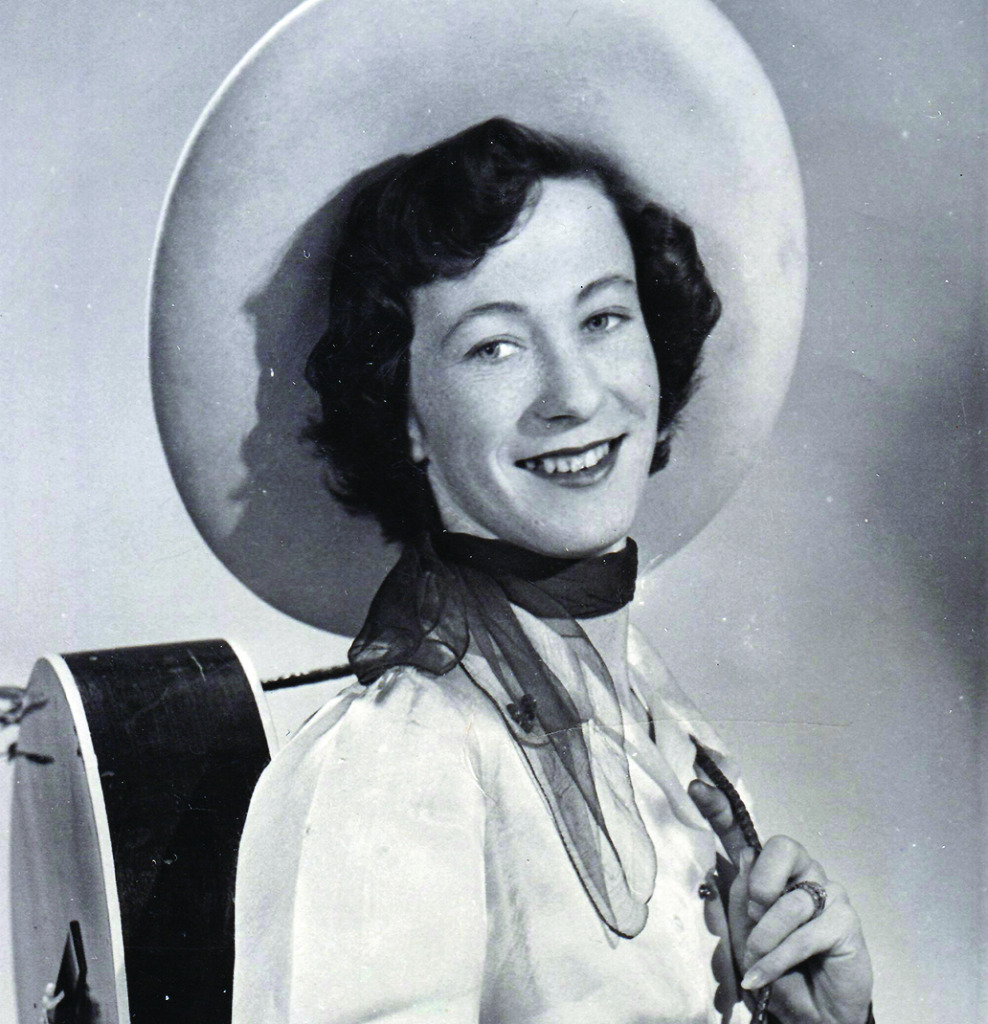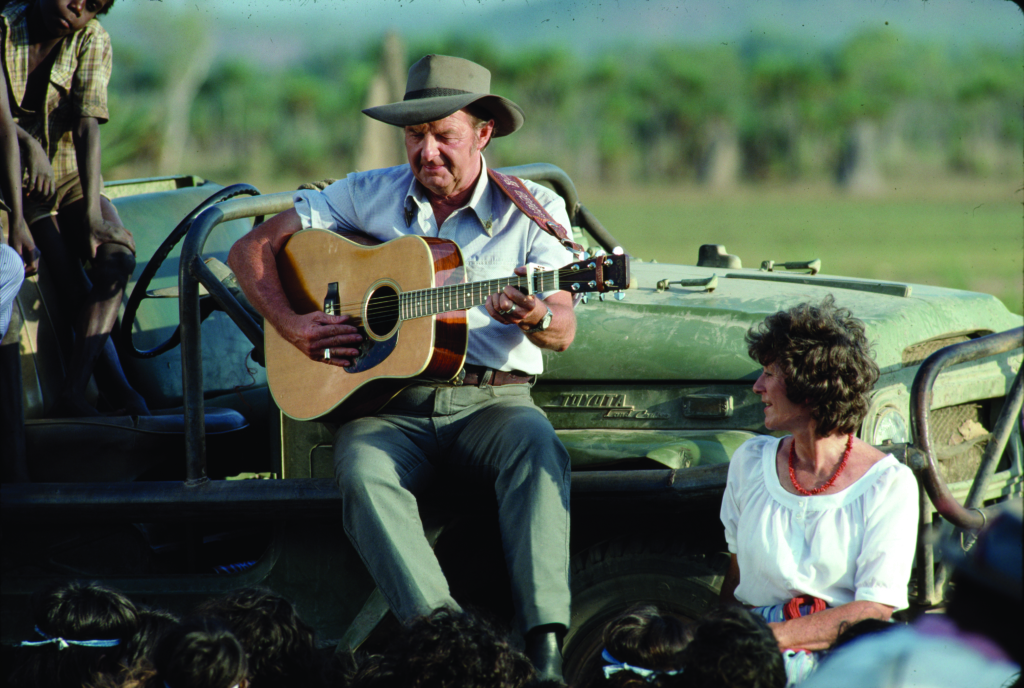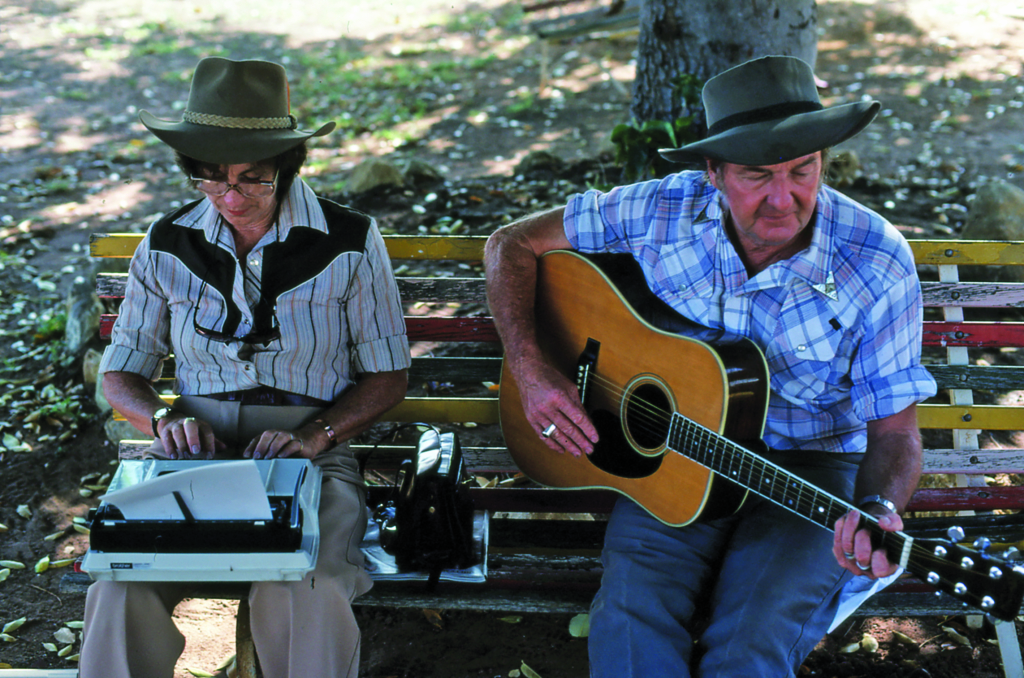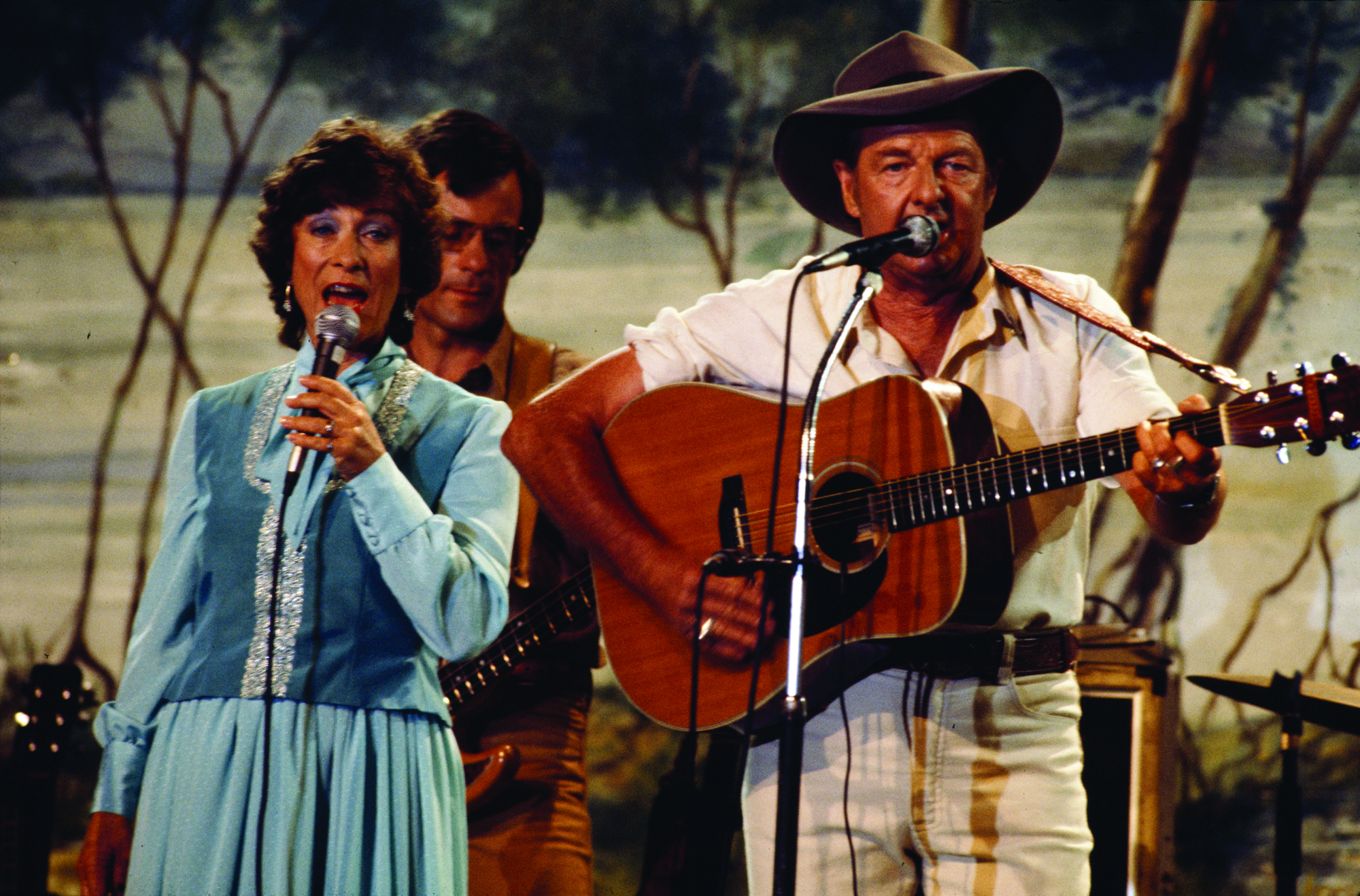Within the first few minutes of Kriv Stenders’ Slim & I (2020), the Australian singer/songwriter Missy Higgins recalls the first time she was exposed to the music of Slim Dusty, which she describes as ‘the most Australian sound I’d ever heard’. Anyone with even a passing awareness of the country singer she’s referring to will surely know what she means. Slim Dusty’s music represents a distinct brand of Australiana, defined by that conversational, grandfatherly singing voice and those simple and undemanding songs (often bush ballads) about ordinary people, rural issues, travelling, family life and so on. And then there is the image: the floppy akubra, the rolled-up shirtsleeves and the welcoming grin on a weatherworn face. Even his chosen stage name – he was born David Gordon Kirkpatrick in 1927 – feels like an expression of the country. The Slim Dusty package is, indeed, as Higgins affectionately puts it, very Australian – or, at least, a certain kind of Australian.
But in 2021, with cultural values evolving and Australian history undergoing thoughtful re-evaluation, it is fair to say that Slim Dusty is not exactly fashionable. It’s hard to imagine that he remains a universally known name in the nation’s increasingly diverse and multicultural households today, but it is also hard to envision him being forgotten; this is, after all, the man who performed ‘Waltzing Matilda’ at the closing ceremony of the 2000 Olympic Games in Sydney.

Director Stenders’ passionate and celebratory film can be regarded as a gentle reminder of who he was, what he meant to people and his legacy. But it is also more than that. With this documentary, Stenders, whose previous films include the wildly successful feature Red Dog (2011) and music documentary The Go-Betweens: Right Here (2017), has chosen to view Kirkpatrick’s life from the perspective of his wife, Joy McKean – the ‘I’ of the film’s title. McKean was absolutely fundamental to Kirkpatrick’s ongoing success over the decades, as many talking heads in Slim & I emphasise. On the one hand, McKean was an artistic force herself, writing or co-writing many of her husband’s most famous songs; on the other, she was the organisational brains at the heart of the Slim Dusty enterprise, taking responsibility for management, logistics, bookings and many other essential duties away from music making.
Over the course of its 106 minutes, Slim & I tells the story of Kirkpatrick’s and McKean’s lives. Beginning with their separate childhoods (in Kempsey and the Hunter Valley, respectively), the film covers their first meeting at a recording session in Sydney, their many years spent touring Australia, the exploding popularity of their music, their creative partnership, changes in fashion and style, family and domestic life, and Kirkpatrick’s death from kidney cancer in 2003 at the age of seventy-six. The film’s tone is never anything but amiable, with Stenders clearly in awe of his subjects.
Slim & I deserves credit for the way it lauds McKean’s talent as a songwriter as much as, or even more than, her roles as wife, mother and manager.
Slim & I’s storytelling relies on three principal devices. One is a vast range of interviews. McKean herself, extraordinarily articulate and spry at ninety, is the driving force among these. Musicians featured include Higgins, Paul Kelly, Troy Cassar-Daley, Chad Morgan, Kasey and Bill Chambers, Keith Urban, Don Walker, Darren Hanlon, and several others. The film also consults historians, critics, friends of the couple, and their children, Anne and David.
The documentary also leans heavily on Rob Stewart’s 1984 feature film The Slim Dusty Movie, which dramatised Kirkpatrick’s younger years and also included performances from Kirkpatrick and McKean themselves. Scenes from this film are woven skilfully into Slim & I, strongly supported by wonderful super 8 recordings – collected by the couple’s grandson James Arneman, who also serves as one of the film’s producers – of his grandparents touring and performing all over the country.[1]‘About the Production’, Universal Pictures, Slim & I production notes, 2020, p. 4. Visually, Slim & I is consistently fascinating, presenting colour footage of concerts and events in rural Australia from the 1940s onwards.
The other narrative device, and perhaps a curious one, is an elegantly bound red book called ‘Slim & I’. A hand turns the pages of this book at regular intervals throughout the documentary as the story of Kirkpatrick and McKean’s life together progresses. This is effective in that it infuses the film with a sort of ‘grand narrative’ feel, and suggests that there is an archetypal dimension to this tale. However, any book titled ‘Slim & I’ does not officially exist; the text in this one appears to be taken from McKean’s 2014 autobiography Riding This Road: My Life – Making Music and Travelling This Wide Land with Slim Dusty. The fact the viewer is never informed of what this book is and where its text comes from (it’s not even mentioned in the closing credits) is a mildly confusing loose end. This mysterious book, created exclusively for the film,[2]Confirmed to author by Universal Pictures representative via email. does, though, feature engaging illustrations from the artist Graeme Callander that bring a welcome playfulness and charm, even when dealing with sobering aspects of McKean’s life, such as her childhood polio.

The theatrical release of Slim & I came almost exactly one year on from the premiere of US filmmaker Ken Burns’ eight-part PBS documentary Country Music. That series is an engrossing and poetic social study of the genre, exploring the magic and mythology of a sometimes-polarising musical style; it has also changed the parameters of how country music might be examined in documentary film. Slim & I actually stands up reasonably well when viewed in relation to Burns’ far more wideranging work; in a somewhat Burns-like way, Stenders addresses the details and dynamics of his subjects’ lives and insightfully places their music and popularity in their social context. Furthermore, an interesting comparison might be made between Kirkpatrick and McKean and two of the stars of Country Music, Johnny Cash and June Carter. Like Carter with The Carter Family, McKean was part of an established family musical act – the McKean Sisters (with younger sister Heather, who is also interviewed in Slim & I) – in her younger years. And, like Carter with Cash, she met and fell in love with an established male solo artist with whom she would perform and compose music for decades, each becoming national icons. In the context of this parallel, Kirkpatrick and McKean emerge as the great love story of Australian country music – albeit without Cash’s drug addiction or ‘outlaw’ reputation.[3]See John Nichols, ‘Johnny Cash: A “Musical Outlaw”’, Green Left, 24 September 2003, <https://www.greenleft.org.au/content/johnny-cash-musical-outlaw>, accessed 18 February 2021.
Indeed, Kirkpatrick and McKean always maintained an image of wholesomeness – something certainly not brought into question in Slim & I. And, to some listeners today, their music might come across as staid, unambitious and conventional. Certainly, experimentation was not their priority, but Stenders’ film does a fine job in exploring the structure and techniques behind certain songs – and shows that, perhaps, they are not so straightforward after all. Cassar-Daley unpacks the innovative chord sequence in ‘The Biggest Disappointment’, while Kelly analyses the unusual interplay between melody and lyrics in ‘Lights on the Hill’. What’s more, certain songs that are played in the film, such as ‘Indian Pacific’, feature electric-guitar parts in the vein of certain fashionable folk-rock acts of the 1960s and 1970s (such as Creedence Clearwater Revival), suggesting their production choices, at least, were more up to date than some might believe. It is not necessarily the primary mission of Slim & I to positively reassess the merit of Slim Dusty’s music, but it does so nonetheless. Conversely, a memorable moment comes when Morgan dismisses the most famous Slim Dusty song, the admittedly awful ‘A Pub with No Beer’: ‘To be honest with you, I hated it and I still do.’
It is important to note that all of the aforementioned songs, ‘A Pub with No Beer’ excepted, were written by McKean. Slim & I deserves credit for the way it lauds McKean’s talent as a songwriter as much as, or even more than, her roles as wife, mother and manager. The viewer might infer that her musical instincts were actually superior to her husband’s – and when her songs are pored over in detail by the likes of Cassar-Daley and Kelly, it is hard to believe otherwise.

Another highlight of Slim & I is a lengthy portion devoted to Kirkpatrick and McKean’s engagement with remote Indigenous communities, which began in the 1960s. The couple fostered a special connection with the Peppimenarti community, south of Darwin; again, the footage of Kirkpatrick and McKean in this setting is wonderful – particularly one snippet of Kirkpatrick enthusiastically singing along with the Aboriginal band Yothu Yindi as they travel on a tiny light aircraft while on tour in 1993. In this section, the storytelling reins are taken by Indigenous writer Gayle Kennedy and music critic Glenn A Baker, both of whom express how passionately adored Slim Dusty was, and remains, among Indigenous audiences.
What Slim & I does not cover in depth is the impact that Indigenous people and culture had on Slim Dusty’s musical output. Even during childhood, Kirkpatrick was enthralled by the playing of Aboriginal guitarist Clive Kelly,[4]See Clinton Walker, Buried Country: The Story of Aboriginal Country Music, rev. edn, Verse Chorus Press, Portland, OR, 2015, p. 170. while his famous song ‘Trumby’ is a ballad about an Aboriginal stockman. In some songs, Kirkpatrick even confronted such themes as the frontier massacres and Aboriginal pastoral labour in the 1950s and 1960s.[5]See Toby Martin, ‘Historical Silences, Musical Noise: Slim Dusty, Country Music and Aboriginal History’, Popular Music History, vol. 15, no. 2, 2019, pp. 215–36. In fact, the documentary opts not to cover Kirkpatrick’s and McKean’s politics at all, aside from brief footage of Slim Dusty and his band performing the anti-war ‘Are the Good Days Gone Forever?’ at the Sydney Opera House.
Slim & I is coherent, warm, visually and technically excellent, and fairly thorough in its chronicling of Kirkpatrick’s and McKean’s lives. Yet there are certain things missing that, had they been included, may have made for an even more impressive film (even if the running time would have ballooned). One of these is the subject of Slim Dusty’s standing overseas, which is hinted at only by mention of the success of ‘A Pub with No Beer’ in London and Dublin, and one fleeting moment of Kirkpatrick being interviewed by the British talk-show host Michael Parkinson.[6]This interview was recorded for an episode of Parkinson in Australia, which aired from 1979 to 1983 on the ABC and Channel 10. See David Knox, ‘Michael Parkinson Specials for TEN’, TV Tonight, 11 March 2015, <https://tvtonight.com.au/2015/03/michael-parkinson-specials-for-ten.html>, accessed 9 February 2021. More time might have been invested in exploring the extent to which Slim Dusty appealed to non-Australian audiences, and, importantly, how much effort was put into ‘breaking’ overseas.

Another omission – and admittedly this is firmly one for music aficionados – is the story behind McKean’s bass guitar. In several still photographs in Slim & I from the 1950s and 1960s, McKean is pictured with the iconic Höfner 500/1 Violin Bass, made most famous by Paul McCartney in the early days of The Beatles. To this viewer, it was an immediately eye-catching detail that is never alluded to: Why did she opt for this instrument? Was she aware of its rock’n’roll association at the time?
Slim & I never strays from its mission of paying heartfelt tribute to McKean and the man to whom she devoted her life. In this, it is highly successful. However, as mentioned, Kirkpatrick and McKean lived wholesome and largely happy and harmonious lives: there is no sex, drugs or rock’n’roll to be found here; no scandal; no ruptures in relationships; not even any serious creative differences. Slim & I might therefore seem to lack a certain friction and drama – and therefore energy – in its narrative (whether this is a problem will probably depend on how big a fan you are of Slim Dusty). In addition, aside from respectively brief mentions of how difficult Kirkpatrick was to live with when the couple settled in Sydney in the 1970s and the ‘rages’ he would fly into late in life as his health failed, there is nothing but loving praise and admiration offered in the documentary for him. As a consequence, the film feels like a ‘hagiopic’ – which, again, is no issue for the existing fan, but for those who have little affinity with the man and the music, the film might seem one-dimensional and monotone, particularly in the daunting wake of Burns’ series.
One further ingredient in the film should be remarked on, and this is music itself. Slim Dusty recordings feature throughout, of course, but many of the interviewed musicians also perform their own versions of Kirkpatrick and McKean’s songs. Some of these are better than others, but Higgins’ version of ‘The Biggest Disappointment’ lingers in the ear long after the film has finished, as does Hanlon’s version of ‘Me and Matilda’ that plays over the closing credits, a sparse but spectacular interpretation that sounds like the melancholy confessions of an outback Leonard Cohen.
McKean turned ninety-one in January 2021, and she is still a musical force – her recent song ‘I Don’t Believe You’[7]McKean co-wrote this song with Arneman and his wife, Flora Smith. See Tyler Jenke, ‘New Joy McKean Song “I Don’t Believe You” Leads Slim & I Soundtrack’, Rolling Stone Australia, 25 August 2020, <https://au.rollingstone.com/music/music-news/joy-mckean-i-dont-believe-you-slim-i-soundtrack-16129/>, accessed 29 January 2021. is included on the Slim & I soundtrack. She is also, it seems, fiercely protective of how Slim Dusty’s name and music are used and licensed.[8]See Damon Cronshaw, ‘Slim Dusty Tribute Shows in Regional NSW Centres Cancelled over Legal Stoush’, The Canberra Times, 7 March 2019, <https://www.canberratimes.com.au/story/5942625/slim-dusty-tribute-shows-cancelled-over-legal-stoush/>, accessed 29 January 2021. Slim & I is a tender portrait of her enduring energy, creativity and loyalty. It is also that rare thing: a celebration of an elder person’s significant contribution to culture produced when they are still around to appreciate the adoration. And Slim & I is, if nothing else, an exercise in adoration.
Endnotes
| 1 | ‘About the Production’, Universal Pictures, Slim & I production notes, 2020, p. 4. |
|---|---|
| 2 | Confirmed to author by Universal Pictures representative via email. |
| 3 | See John Nichols, ‘Johnny Cash: A “Musical Outlaw”’, Green Left, 24 September 2003, <https://www.greenleft.org.au/content/johnny-cash-musical-outlaw>, accessed 18 February 2021. |
| 4 | See Clinton Walker, Buried Country: The Story of Aboriginal Country Music, rev. edn, Verse Chorus Press, Portland, OR, 2015, p. 170. |
| 5 | See Toby Martin, ‘Historical Silences, Musical Noise: Slim Dusty, Country Music and Aboriginal History’, Popular Music History, vol. 15, no. 2, 2019, pp. 215–36. |
| 6 | This interview was recorded for an episode of Parkinson in Australia, which aired from 1979 to 1983 on the ABC and Channel 10. See David Knox, ‘Michael Parkinson Specials for TEN’, TV Tonight, 11 March 2015, <https://tvtonight.com.au/2015/03/michael-parkinson-specials-for-ten.html>, accessed 9 February 2021. |
| 7 | McKean co-wrote this song with Arneman and his wife, Flora Smith. See Tyler Jenke, ‘New Joy McKean Song “I Don’t Believe You” Leads Slim & I Soundtrack’, Rolling Stone Australia, 25 August 2020, <https://au.rollingstone.com/music/music-news/joy-mckean-i-dont-believe-you-slim-i-soundtrack-16129/>, accessed 29 January 2021. |
| 8 | See Damon Cronshaw, ‘Slim Dusty Tribute Shows in Regional NSW Centres Cancelled over Legal Stoush’, The Canberra Times, 7 March 2019, <https://www.canberratimes.com.au/story/5942625/slim-dusty-tribute-shows-cancelled-over-legal-stoush/>, accessed 29 January 2021. |





